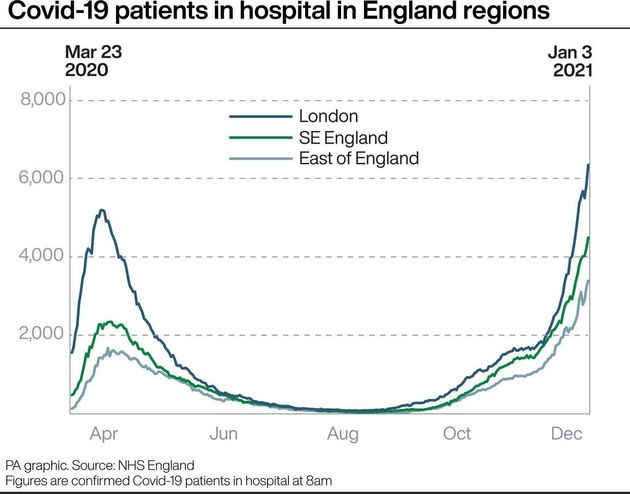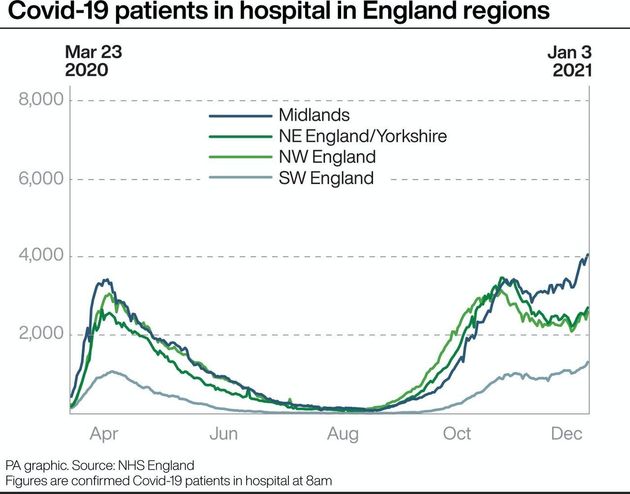There has been a massive increase in coronavirus cases across the country after the Christmas period, including in areas that two days ago were seeing a drop in infections.
Even more concerning is that despite increasing pressure on hospitals around the UK, current hospital admissions are unlikely to account for a coming surge caused by increased socialising over the holidays.
“I think the hospital data doesn’t yet reflect Christmas but will start to this week which is even scarier,” Dr Christina Pagel, director of the Clinical Operational Research Unit at UCL, told HuffPost UK.
“It’s about 10 to 14 days from infection to needing to be in hospital. So you’d expect hospital admissions from people infected on Christmas day to start today onwards.”

The latest infection data from the NHS paints a grim picture of what’s in store for the country over the next few weeks…
- Cases have more than doubled in just seven days in 20 areas of England
- 12 days ago cases were decreasing in 23 areas. Today the number is just two
- The UK’s infection increase is outpacing most other countries
The data below is taken from NHS Digital and relates to the seven-day period up to December 31. It shows the percentage rise in cases followed by the number of cases per 100,000 people in brackets.
For context, the government’s own threshold for quarantining overseas travellers is 20 cases per 100,000 people over a seven-day average.
Where cases are rising the fastest in England
- Isle of Wight 221% (693.4)
- Halton 217% (633.6)
- Cornwall and Isles of Scilly 204% (294.7)
- Knowsley 191% (538.9)
- Sefton 171% (484.1)
- Shropshire 168% (265.5)
- Wirral 162% (559.5)
- Redcar and Cleveland TIER 4 153% (295.3)
- Sunderland TIER 4 141% (465.6)
- Liverpool 132% (453.0)
- Bournemouth Tier 4 128% (495.8)
- Telford and Wrekin 121% (311.9)
- Cumbria TIER 4 120% (481.8)
- South Tyneside TIER 4 118% (484.2)
- Warrington 109% (532.3)
- York 107% (490.9)
- Middlesborough 103% (455.4)
- Torbay 103% (113.0)
- North Yorkshire 102% (338.5)
- Cambridgeshire TIER 4 100% (445.4)
Where cases are decreasing
There are 151 areas listed on the NHS dashboard and 12 days ago, 23 saw a decrease in cases over the last seven days, most of them in the north and Yorkshire.
Now only two areas – Richmond-upon-Thames and Wandsworth – have seen a decrease in the last seven days.
How the UK compares to other countries
The UK’s infection trend line compared to the top ten countries with the highest number of confirmed cases is stark.
When looking at the cumulative total of cases, all other countries decreased or remained relatively flat through December.
The UK’s has nearly tripled.
The latest data show a 33% rise in the number of confirmed coronavirus patients in hospital in England between Christmas Day and January 2, figures which have caused alarm in Whitehall and the health service.
Hospitals in London have a record number of patients with Covid-19. A total of 6,358 patients were in hospital in the capital as of 8am on January 3. This is more than double the number two weeks ago (3,067 patients on December 20).
During the first wave of the virus, patient numbers peaked at 5,201 on April 9.

Boris Johnson said on Monday there is “no question” tougher measures will have to be imposed.
Speaking during a visit to Chase Farm Hospital in north London to meet some of the first people to receive the Oxford vaccine, the prime minister said there were “tough tough” weeks to come.
“If you look at the numbers there’s no question we will have to take tougher measures and we will be announcing those in due course,” Johnson said.

Matt Hancock on Monday indicated that parts of England under tier 3 restrictions will be upgraded to tier 4.
The health secretary also refused to rule out another national lockdown amid concerns the new variant coronavirus is spreading out of control and the “old tier system is no longer strong enough”.